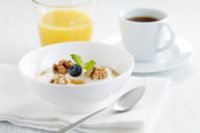In the last five years, Greek yogurt has gone from 1% to 36% share of the total yogurt market. Some estimate Greek yogurt and related products will account for more than 50% share of market in the near future.
Many attribute the rise to consumers’ preference for the product’s higher-protein content as well as the associated thicker and creamier texture. The gradual reduction of milk solids and acidity in traditional (non-concentrated) yogurts which makes them more like pudding cups could have been the tipping point that made consumers more receptive to a price/value relationship associated with the higher-cost, higher-protein introductions.
In reality, these types of high dairy-protein (high total milk solids) yogurts have been around for a long time and are known in different parts of the world as labneh, ymer, skry, basa, torba, syuzma, mastou, zabady, chakka and ititu.
Here in the United States, higher-protein yogurts have come to be known as Greek yogurt. There is no legal standard to define a minimum protein content or distinct manufacturing process for it. Nonetheless, Greek yogurts typically have protein contents ranging from 6% to 12%, or about 1.5 to 4 times that of traditional yogurt.
Concentrating protein
Some argue that the only way to make Greek yogurt is by straining the cultured milk mixture (yogurt) through a cloth bag to concentrate the cultured milk coagulum. Sometimes mild pressure is applied to shorten the draining time. The process is simple and requires minimal investment in equipment. However, complete straining can take from six to 18 hours. This can have a negative impact on shelf life and is not feasible for large-scale operations.
More typically, concentration is achieved by using a centrifugal separator. The fermented milk is passed through a specially designed separator to concentrate the coagulated solids. Up to two-thirds of the original milk volume is removed to achieve the degree of protein concentration desired. But the large volume of acid whey that has been removed represents a challenging by-product stream for manufacturers to utilize or treat as a waste stream.
Ultrafiltration also has been shown to be effective to concentrate the fermented milk. After fermentation, the yogurt is heated to approximately 120F, passed through a multistage ultrafiltration system, cooled and packaged. Nearly all the milk proteins are retained (including those soluble whey proteins not associated to caseins by a heat treatment) because the pore size of the membrane is too small for whey proteins to pass into the permeate. However, membrane fouling can reduce filtration rates and increase cleaning costs. The permeate from this process remains problematic because it is a dilute lactose solution that has a high mineral content, low protein content and a low pH.
Vacuum evaporation or reverse osmosis also have been explored to remove only water from the fermented milk mixture and concentrate all the fermented milk solids. While these approaches result in clean by-product streams (water), any residual lactose in the fermented milk is also concentrated and hence the ratio of protein-to-lactose in the finished product is lower than the ratio using the other processes mentioned above.
Increasing protein
Higher-protein yogurt also can be achieved through formulation prior to fermentation. Protein in the milk mixture can be increased by the addition of dairy protein-based ingredients (that is, whey protein concentrate, milk protein concentrate, nonfat dry milk or sodium caseinate).
One key advantage of a “no whey separation” approach is that it is now amenable to either cup set or bulk set yogurt manufacture. Further, constituents such as calcium, which become more soluble in the acidic conditions of yogurt, are all retained since there is no drainage step.
Depending on the protein ingredient(s) used, they can impact fermentation times. You may need to change the cultures used as some yogurt microorganisms may not grow as well under the higher solids conditions. Additionally, these ingredients increase the buffering capacity of the system; hence more acid needs to be developed to achieve the same pH of typical yogurt. These factors can result in longer fermentation times and a more acidic taste in the finished product. However, the fact that this approach results in essentially no by-product is very attractive, and essentially no additional equipment is needed to make this product in existing cultured products facilities.
The best choice?
There are pros and cons to all the approaches in producing higher-protein yogurts. There really is no simple answer to what is “best.” Further, there may be unanswered questions about higher protein (or higher solids yogurts) that require more investigation; for example, how do specific probiotic bacteria survive in this product?
In the end, consumers will continue to seek the price-value relationship that reflects their desire for taste, nutrition and convenience.
Don’t lose sight of the fact that while we debate what Greek yogurt is or is not, soy processors will launch higher-protein fermented products of their own in an attempt to lure consumers.




